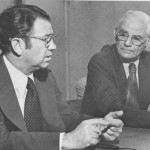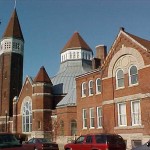Over the years, a memorial to the father of the Indianapolis parks system has been languishing in the city’s Riverside Park. The unfortunate irony of the disrepair of the Thomas Taggart Memorial has landed it on Indiana Landmarks’ 2011 Ten Most Endangered List.
The preservation group bemoans the unsightliness of the fence that now surrounds the colonnade, to keep visitors safe from the crumbling limestone. Erected in 1931, the neoclassical monument once boasted a fountain–which is no longer functional.
The weary landmark is a far cry from the vision Taggart had for Indianapolis as its mayor from 1895-1901. Convinced that city dwellers required the balm that only green space could provide, Taggart acquired and dedicated the hundreds of acres that would become White River, Highland, and Brookside Parks. Instrumental in elevating the city’s railroad tracks and improving the roads, Taggart was a bicycling enthusiast who won his second term in office in part thanks to the League of American Wheelmen lobby.
Born in Ireland in 1856, Taggart came to the US with his family as a child. Moving to Indiana as a young adult, Taggart served as Marion County auditor and Democratic State Chairman before being elected mayor in 1895. After completing his third term, Taggart took the helm of the Democratic National Committee. In 1916 the former mayor was appointed to the US Senate to complete Benjamin Shively’s term after the senator’s untimely death.
Along the way, the politician had become an entrepreneur. Assembling a group of backers to purchase the French Lick Springs Hotel in 1901, Taggart added wings, modernized the facilities, designed state-of-the-art golf courses, and stepped up production of the spa’s signature Pluto Water. After Taggart convinced the Monon Railroad to create a spur that brought Chicago guests to the hotel’s front door, society’s elite ushered in, along with national figures in the Democratic Party. Although Taggart died in 1929, the family held an interest in the resort until 1946.





















